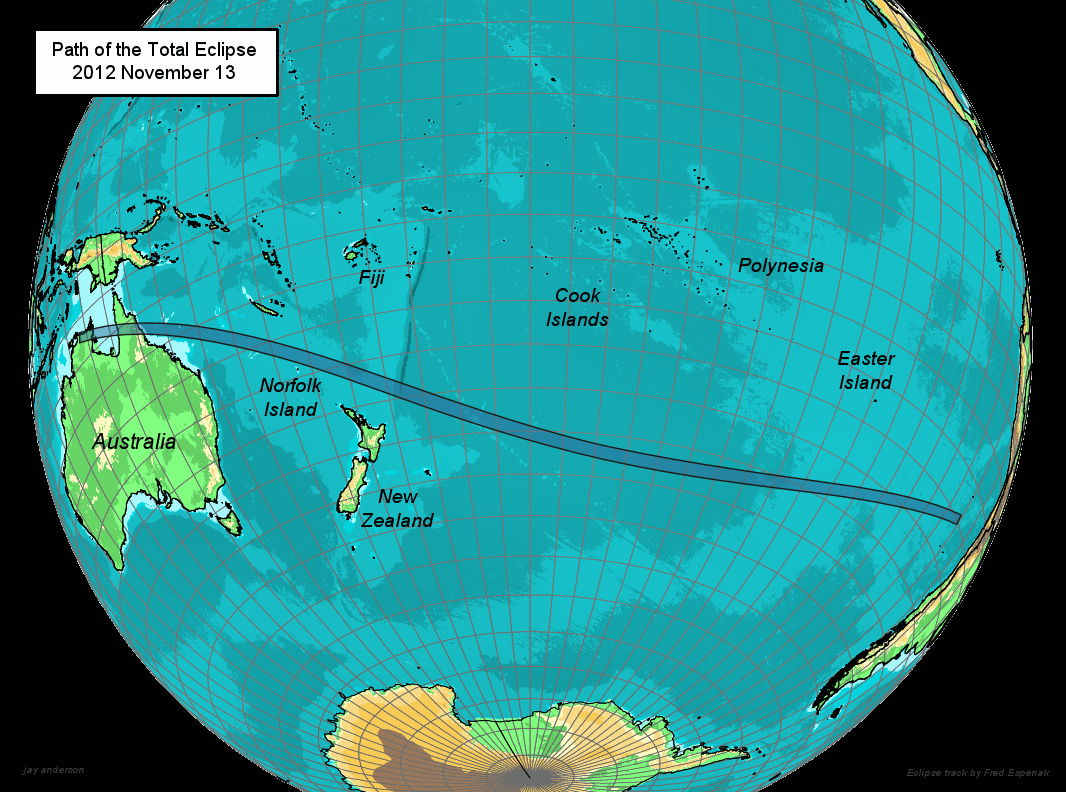Total Solar Eclipse Webcasts: Watch Tuesday's Sun Event Here

UPDATE: See photos of Tuesday's total solar eclipse here: Total Solar Eclipse of 2012 (Photo Gallery )
Read the full wrap story here: Rare Total Solar Eclipse Darkens Skies Over Australia
You can see a video of the solar eclipse from space here: Partial Solar Eclipse Seen 3X By Satellite
The moon will block the sun today in a total solar eclipse, but only for spectators in parts of Australia and in the southern Pacific Ocean. For the rest of us, several webcasts will be available to remotely watch the celestial alignment of the sun and moon.
The only total solar eclipse of 2012 will begin at 3:35 p.m. EST (2035 GMT) today, though it will be early Wednesday morning (Nov. 14) for observers watching the event in Australia.
The path of totality is about 108 miles (174 kilometers) wide and 9,000 miles (14,500 km) long, and covers a three-hour period. Much of the solar eclipse's path is over the open Pacific Ocean, making it difficult to observe. [Video: Watch Path of Nov. 13-14 Total Solar Eclipse]
Slooh Space Camera webcast
Breaking space news, the latest updates on rocket launches, skywatching events and more!
For solar fans not in the eclipse's path, the Slooh Space Camera will provide a free webcast of the eclipse from Cairns, Australia, beginning at 2:30 p.m. EST (1930 GMT). You can see Slooh's stream below, including pre-eclipse events:
A direct link to the Slooh webcast is here: http://www.slooh.com.
Panasonic Eclipse Live by Solar Power 1 webcast
Panasonic is providing a live total solar eclipse webcast from northern Australia. The webcast is powered by Panasonic's high-efficiency HIT solar panels. Watch live below:
Direct link: http://www.ustream.tv/channel/panasonic-eclipse-live-by-solar-power-1
Tourism Tropical North Queensland webcast
The Tourism Tropical North Queensland, a tourism bureau, meanwhile, is expecting 60,000 spectators to watch the solar eclipse from Cairns. It is working with the Astronomical Association of Queensland and NASA to webcast the eclipse. The webcast will begin at 1 p.m. EDT (1800 GMT), which corresponds to 5 a.m. local time in Queensland, and will be carried here:
A direct link to the Cairns tourism group's webcast is here: http://www.ustream.tv/cairnseclipse2012.
North Dakota eclipse chasers webcast
The University of North Dakota has sent a team of eclipse chasers to Cairns to capture views of the total solar eclipse. The webcast will begin at 3 p.m. EST (2000 GMT) here: http://www.sems.und.edu.
or on Facebook: http://www.facebook.com/SemsSunEarthMoonSystem.
Warning: If you are planning to watch the total solar eclipse in person, be extremely careful. Never look directly at the sun, either with the naked eye or through telescopes or binoculars without the proper filters. To safely view solar eclipses, you can purchase special solar filters or No. 14 welder's glass to wear over your eyes. Standard sunglasses will NOT provide sufficient protection.
Tuesday's solar eclipse is not the only skywatching treat to grace the November skies.
The annual Leonid meteor shower peaks overnight Saturday (Nov. 17), and then flares back up for a later show on Nov. 20, according to SPACE.com's skywatching columnist Joe. Rao. November's skywatching events conclude on Nov. 28 with a penumbral eclipse of the full moon.
Editor's note: If you are in Australia or along the solar eclipse path and snap an amazing photo of Tuesday's total solar eclipse that you'd like to share for a possible story or image gallery, please send images, comments and location information to managing editor Tariq Malik at tmalik@space.com.
Follow SPACE.com on Twitter @Spacedotcom. We're also on Facebook and Google+.

Space.com is the premier source of space exploration, innovation and astronomy news, chronicling (and celebrating) humanity's ongoing expansion across the final frontier. Originally founded in 1999, Space.com is, and always has been, the passion of writers and editors who are space fans and also trained journalists. Our current news team consists of Editor-in-Chief Tariq Malik; Editor Hanneke Weitering, Senior Space Writer Mike Wall; Senior Writer Meghan Bartels; Senior Writer Chelsea Gohd, Senior Writer Tereza Pultarova and Staff Writer Alexander Cox, focusing on e-commerce. Senior Producer Steve Spaleta oversees our space videos, with Diana Whitcroft as our Social Media Editor.

